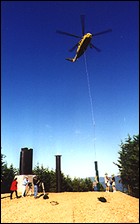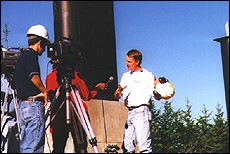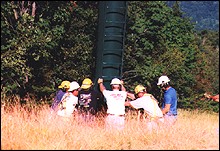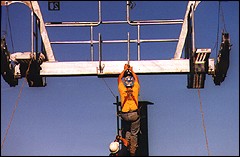
|
|
Planting a tower.
Photo by M. Scott Smith.
|
Assisted by righthand man Kelly Stern, Stevens is part of a team at Snowshoe that is making sure word gets out about the renaissance of the resort. When parent company Intrawest purchased the 25-year old resort in the fall of 1995, it promised to make major improvements. Intrawest has kept its word, investing over $50 million into the resort through the addition of new lifts, new trails, new activities, and new real estate. And more improvements are on the way in the coming years, ensuring that Stevens and Stern keep busy for some time to come. But the hard work is worth it: they’ll be among the first to try out Snowshoe’s second high-speed lift, and their mountaintop office is located within steps of the slopes, so a quick carve down the mountain is never far away.
The addition of a state-of-the-art high-speed lift is a pretty big deal for any ski resort, especially for a resort in the Mid-Atlantic region. The addition of a second high-speed lift is even bigger news, and area television stations and publications, including DCSki, were invited to witness the installation first-hand.
Snowshoe selected Garaventa CTEC, one of the largest lift manufacturers in the world, to design and install the new Western Express chairlift, which is replacing a fixed-grip lift that served Cupp Run. Unlike the old lift, which took an endless 22 minutes to transport skiers and snowboarders 1.5 miles up the mountain, the new lift will take just 6 minutes. An additional trail, Shay’s Revenge, has been cut into the mountain, giving the 1,500-foot vertical Cupp Run a sibling of the same height. Installation of a high-speed chairlift into the side of a tree-lined mountain is a major technical undertaking that is aided greatly by the use of a cargo helicopter and a skilled pilot.
Each lift tower is brought up the mountain, one by one, and carefully lowered into a pre-built foundation. Next, the helicopter fetches the crossarm, which it lowers on top of the lift tower. The crossarm contains the wheels that the lift cable will roll across. Through careful and coordinated teamwork between the helicopter pilot and a ground crew of a dozen, a complete tower can be installed in about 20 minutes.

|
|
Garaventa CTEC’s John Dearborn explains some safety precautions to NBC television reporters.
Photo by M. Scott Smith.
|
“We’ve never had an accident with helicopters before, but the helicopter is equipped with a siren. If the pilot begins to have any difficulty, he will sound the siren,” Dearborn explained.
“So if we hear a siren, we should run?” half-joked a television reporter, with a weak smile.
“No, no, you never want to turn your back on the helicopter. Always keep an eye on it,” Dearborn replied.
Whenever thousands of pounds of metal are being swung around in the air, there is a possibility of an accident. Prior to witnessing the installation, reporters had to sign a requisite waiver releasing Snowshoe and Garaventa CTEC from liability in the event of an accident. The waiver essentially said: if, due to a freak accident, you become an integral feature of the new chairlift, you won’t sue us.
Sade Baderinwa, a television reporter from an NBC affiliate in Roanoke, Virginia, was clearly intrigued by the safety aspect of the story. She repeatedly asked questions about the dangers of a lift installation, but Dearborn and other Garaventa CTEC representatives reiterated the safety precautions taken and their excellent track record. Indeed, the entire lift installation was a carefully orchestrated event and went without a hitch.

|
|
Ground crew members secure a tower.
Photo by M. Scott Smith.
|
Reporters were allowed within a dozen feet of the ground crew during the installation. After interviewing various officials, it was time for the installation to begin, and Snowshoe officials, journalists, and the construction crew waited for the helicopter to appear. The lift components were placed in a staging area at the bottom of the mountain, just across the street from a horse stable. All components had earlier been trucked in. The helicopter would alternate between picking up a tower and crossarm. Once a long cable extending from the bottom of the helicopter was attached to a tower or crossarm at the base of the mountain, the helicopter flew up the side of the mountain, lowerering the piece into place as the ground crew secured the component.
As the helicopter neared, the powerful blades whipped up gale-force winds that made it difficult for the assembled journalists to stand. Two television reporters took advantage of the hurricane-like atmosphere to record a segment set against the loud, hovering helicopter. On several occasions, hard hats went flying off heads as photographers attempted to shoot the action without toppling over.
In a few minutes, having deposited its cargo, the helicopter would rise in the air, turn, and zip back down the mountain for the next piece. A sudden and awkward silence would fall over the mountainside as the helicopter retreated and disappeared.

|
|
Securing the crossarm.
Photo by M. Scott Smith.
|
As journalists enjoyed the installation from a very close vantage point, other curious Snowshoe visitors observed the installation from the Cupp Run overlook, which offers an excellent view of Cupp Run and the newly-cleared Shay’s Revenge from a distance.
A young boy watched with wide eyes as the helicopter rose up the side of the mountain, towing a tower behind a long cable. The repetitive process - tower, crossarm, tower, crossarm - didn’t seem to bore the boy or his family. It’s not every day that one can witness the installation of a chairlift, and a lot of cars slowed down or stopped on the main road as intrigued drivers took in the unusual sight.
Within a couple hours, most of the lift towers had been installed. The next step is to thread the chair cable across the crossarms, and to build the upper and lower terminals. According to Stevens, the entire lift should be installed by the end of September. After load-testing, the lift will be ready to roll.
Just in time for the 1998/99 winter season, which for Snowshoe should start by Thanksgiving.
And chances are, Stevens and Stern will be among the first to ride the Western Express and carve down Shay’s Revenge.
M. Scott Smith is the founder and Editor of DCSki. Scott loves outdoor activities such as camping, hiking, kayaking, skiing, and mountain biking. He is an avid photographer and writer.
There are no reader comments on this article yet.

Join the conversation by logging in.
Don't have an account? Create one here.